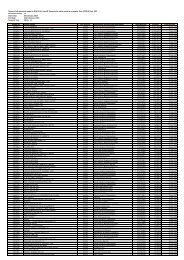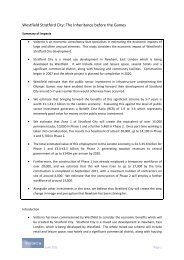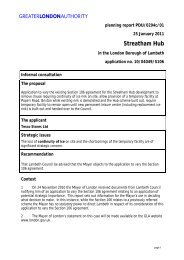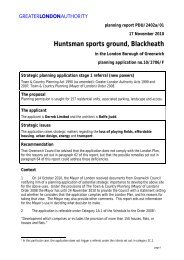282 <strong>Vauxhall</strong> <strong>Nine</strong> <strong>Elms</strong> <strong>Battersea</strong> <strong>Opportunity</strong> <strong>Area</strong> <strong>Planning</strong> <strong>Framework</strong>1 Introduction2 Consultation strategyThis report provides the strategic frameworkfor a site-wide, low carbon, decentralisedenergy scheme, to deliver environmentalbenefits over and above what mightotherwise be achieved by individualdevelopments on a plot-by-plot basis.Decentralised energy schemes have a criticalrole to play in reducing London’s CO2emissions. In a broad sense, decentralisedenergy means the generation of electricityclose to the point of use, enabling heatreleased during the power generation processto be captured and distributed via a districtheating network.This approach enables higher fuel conversionefficiencies and lower energy distributionlosses which together can contribute toLondon’s CO2 reduction target of 60% by2025 as well as delivering on the target setout in the 2007 Climate Change Action Planfor 25% of London’s electricity to be met bedecentralised generation by 2025.District heating networks are fundamentalto such schemes, and in order to have thesignificant impact that is required, extensiveheat networks will need to be installed inLondon over the next few years, on a scalewhich has not been seen before in the UK.Such schemes will enable the distributionof low-carbon heat, captured from powerstations, waste to energy facilities anddedicated CHP plants for space heating andhot water production in buildings & industryacross the city.The <strong>Vauxhall</strong> <strong>Nine</strong> <strong>Elms</strong> <strong>Battersea</strong> (VNEB)<strong>Opportunity</strong> <strong>Area</strong> (OA) lends itself to districtheating as a low or zero cost CO2 mitigationtechnology, due to the scale, diversityand density of the regeneration activity.However, district heating networks (DHNs)need planning, co-ordination and specificpolicy and the OAPF is a sensible place to setout the overall ambition and a route map fordeveloping such a scheme.The London Plan already expects all majornew developments to either connect intoCCHP/CHP distribution networks wherethese exist, or provide site-wide CCHP/CHPschemes with communal heating to enablefuture connection into larger, low carbondistrict heating networks. This energy masterplan is intended to build on these principles,helping developers to comply with theserequirements by identifying opportunitiesfor schemes, which incorporate multipledevelopments and potentially connect toexisting buildings, delivering benefits of scaleand diversity, which may not otherwisebe realised.This study has been undertaken by theLDA in consultation with a number ofkey stakeholders, listed below, who haveprovided much of the data and information,which is included.Covent Garden Market Authority (CGMA),London Borough of Lambeth, LondonBorough of Wandsworth, Treasury Holdings,Ballymore, National Grid, EDF Energy,Berkeley Homes and the GLA’s waste team..
<strong>Vauxhall</strong> <strong>Nine</strong> <strong>Elms</strong> <strong>Battersea</strong> <strong>Opportunity</strong> <strong>Area</strong> <strong>Planning</strong> <strong>Framework</strong>TA 05 Energy masterplanMayor of London 2833 OA energy characteristics3.1 OverviewIn energy terms, the VNEB area ischaracterised by five distinct developmentareas:• <strong>Nine</strong> <strong>Elms</strong> and <strong>Battersea</strong> PowerStation District• <strong>Vauxhall</strong> Gateway• Albert Embankment & Environs• NCGM & Patmore Estates• Stewarts Road Industrial <strong>Area</strong>Development area No. units Residential (m 2 ) Retail (m 2 ) Office (m 2 ) Industrial (m 2 ) Total (m 2 ) % of totalAlbert Embankment 1,173 82,110 22,500 25,000 10,000 139,610 8%<strong>Vauxhall</strong> 2,513 175,910 25,000 75,000 10,000 285,910 17%NCGM, Patmore 586 41,020 2,500 0 0 43,520 3%<strong>Battersea</strong> <strong>Nine</strong> <strong>Elms</strong> 12,479 873,530 100,000 255,000 30,000 1,258,530 73%Stewarts Rd Estate 0 0 0 0 0 0 0%Totals 16,751 1,172,570 150,000 355,000 50,000 1,727,570 100%Table 1 Development area land use schedule (Option 5)The table 1 summarises the newdevelopment planned in these five areas(based on the Option 5 developmentscenario – the optimum developmentcapacity within the OA). The figures do notinclude the NCGM.Table 1 shows that almost 75% of newdevelopment is likely to take place in the<strong>Battersea</strong> <strong>Nine</strong> <strong>Elms</strong> area. Around 12,500new homes are planned here at a density of~260units/ha in addition to up to 400,000m2 of commercial space. The high densityand mixed use nature of development inthis area lends itself to an area-wide districtheating scheme, however, the aggregateddemand is dominated by new residentialdevelopments. The areas of highestelectricity consumption will be the newoffices and other commercial areas, wherepower hungry IT equipment will result inincreased levels of comfort coolingDevelopment in the <strong>Vauxhall</strong> area is likelyto be in the form of tall, high densitymixed use buildings. The density of thesebuildings, combined with high specifications,particularly in offices, will result indevelopments with very high electricaldemands. Addressing space cooling in asustainable way will be a major factor in thedesign of buildings in this area. The majorityof heat demand in <strong>Vauxhall</strong> will arise fromthe proposed residential units.Overall, less new development is planned inthe northern part of the OA, including AlbertEmbankment and the area to the east of therailway line. Existing buildings here includecommercial offices and public buildingsoccupied by the Metropolitan Police andLondon Fire Brigade. The area to the eastof the railway line is generally lower densityand again although some development isexpected, it is less significant compared tothe areas further west.The Stewarts Road area to the west ofthe OA consists primarily of industrialand commercial units and is home toapproximately 145 businesses. The railwayyards located on the south western fringe ofthe OA are more industrial in nature. Littleis know currently about the specific energyrequirements of the various operations andbuildings in this area although they representan opportunity to increase the diversity ofheat load once should an area-widescheme evolve.NCGM, a wholesale fruit & vegetable market,owned and managed by the Covent GardenMarket Authority (CGMA) is located on alarge site south of the railway line connecting<strong>Vauxhall</strong> with <strong>Battersea</strong> Park. The market isdue to be redeveloped over the next3-8 years.The Patmore Estate is located in the <strong>Nine</strong><strong>Elms</strong> area and includes around 470existing homes.More detailed information about specificdevelopment sites and their plans in respectof energy services is provided in Section 4.
















